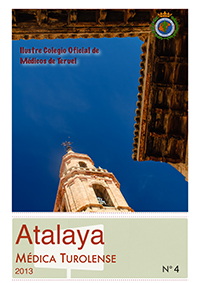LUXACIÓN GLENOHUMERAL BILATERAL. A PROPÓSITO DE UN CASO
Palabras clave:
colaboración científica, luxación, traumatologíaResumen
Poco frecuente que representa entre el 1,5% y el 4,3% de las luxaciones glenohumerales.
La escápula presenta una angulación de unos 45º con respecto a la pared posterior de la cavidad torácica, con la glenoides en situación posterior a la cabeza humeral. Debido a esta particularidad anatómica, es menos probable el desplazamiento posterior de esta ante un traumatismo. La mayoría de traumatismos leves resultan en meros desgarros capsulares o pequeños arrancamientos óseos glenoideos.
La luxación glenohumeral bilateral posterior aparece en varones jóvenes tras traumatismos de elevada intensidad, contracturas musculares bruscas o secundariamente a crisis convulsivas por cuadros de hipoglicemia, descargas eléctricas o terapia de electroshock, enfermedades neuromusculares y psiquiátricas, síncopes o epilepsia. Dentro de su rareza no es infrecuente la bilateralidad.
Referencias
1. Mathis RD. Bilateral shoulder dislocation: an unusual occurrence. J Emerg Med 1990;8:41-3.
2. Marty B, Simmen HP, Kach K, Trentz O. Bilateral anterior dislocation fracture after an epileptic seizure. A case report. Unfallchirurg 1994;97:382-4.
3. Cresswell TR, Smith RB. Bilateral anterior shoulder dislocations in bench pressing: an unusual cause. Br J Sports Med 1998;32:71-2.
4. Litchfield JC, Subhedar VY, Beevers DG, Patel HT. Bilateral dislocation of the shoulders due to nocturnal hypoglycaemia. Postgrad Med J 1988;64:450-2.
5. Ribbans WJ. Bilateral anterior dislocation of the shoulder following a grand-mal convulsion. Br J Clin Pract 1989;43:181-2.
6. Gali F, Molina A, Felipe D, Andolz M. Bilateral luxation of the shoulder and epiphyseal detachment caused by an electrical discharge. Med Clin 1986;87:820.
7. Gazdzik T. A case of recurrent bilateral shoulder dislocation in a patient with Felty’s syndrome. Chir Narzadow Ruchu Ortop Pol 1996;61:531-3.
8. Cosgan PS, Binns MS, Wallace WA. Undiagnosed bilateral anterior dislocation of the shoulder. Injury 1990;21: 409.
9. Dlimi F, Rhanim A, Lahlou A. Bilateral anterior dislocation of the shoulders at the start of a backstroke competition. J Orthop Traumatol. 2012 Mar;13(1):47-9. Epub 2012 Feb 9.
10. Tripathy SK, Sen RK, Aggarwal S, Dhal SS, Tahasildar N. Simultaneous bilateral anterior shoulder dislocation: report of two cases and review of the literature. Chin J Traumatol. 2011 Oct 1;14 (5):312-5.


